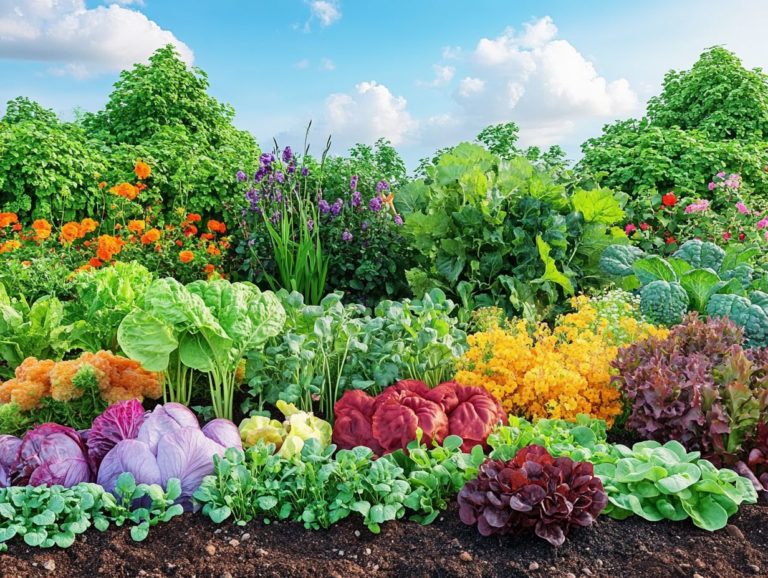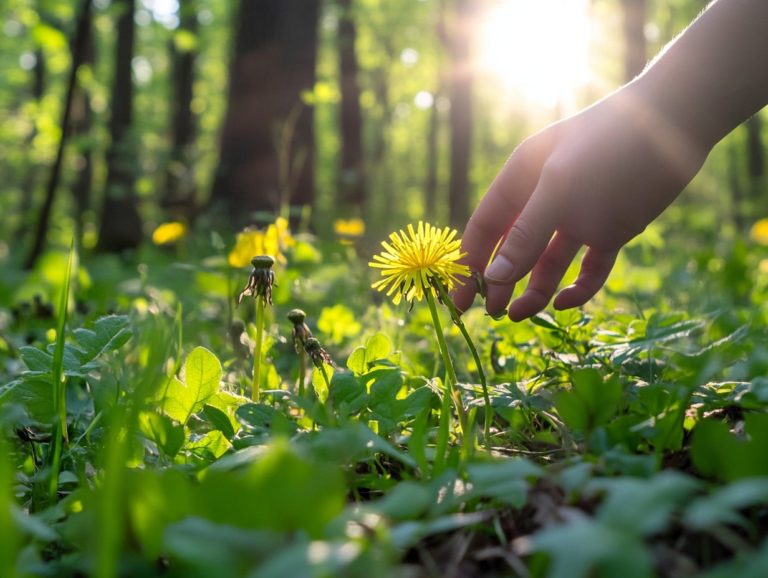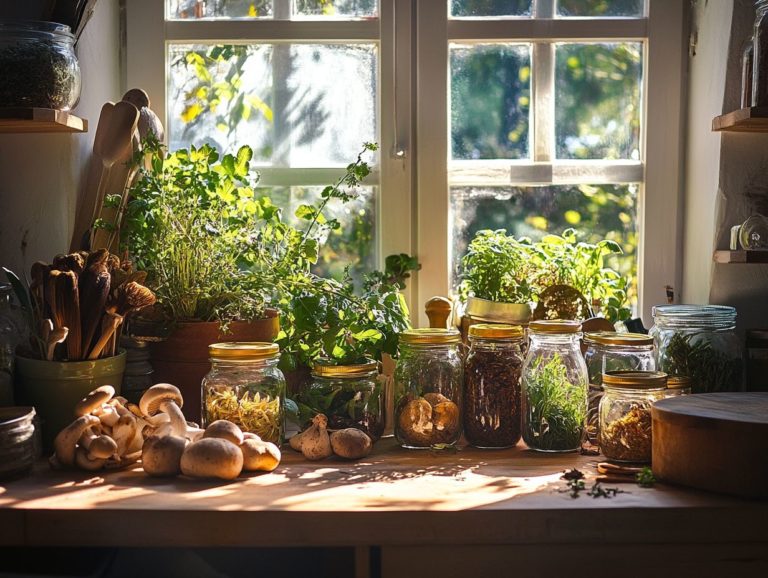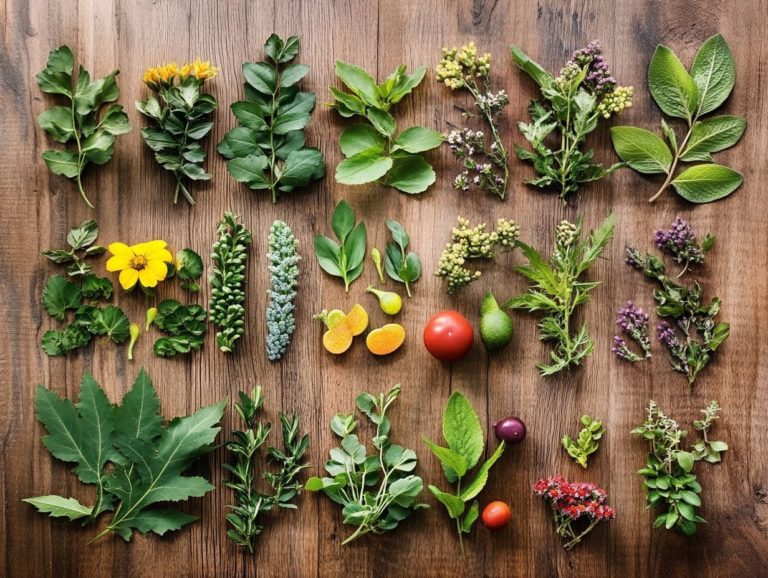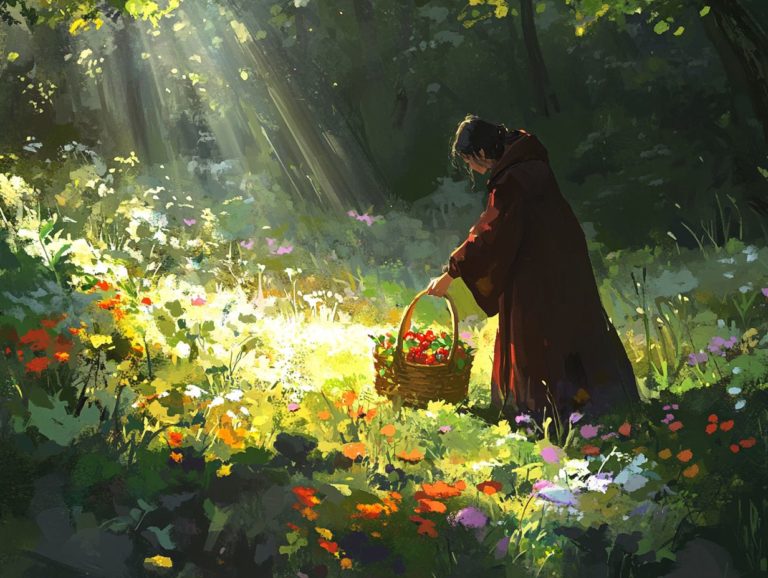5 Best Edible Plants for Urban Foraging
Urban environments are brimming with delicious foods just waiting for you to uncover them.
From dandelions to wild garlic, many common plants can be foraged for nutritious meals right in your own backyard or local park. This article delves into the five best edible plants for urban foraging, which invites you to search for and gather wild edible plants in urban areas. It showcases their benefits, safe harvesting methods, and delightful ways to incorporate them into your cooking.
It also explores the broader impact of urban foraging on the environment and offers tips for safely identifying these hidden gems. Elevate your meals now while forging a deeper connection with nature that promotes mental well-being and fosters a sense of community! Gatherings encourage people to engage in foraging and share their experiences in your city!
Contents
- Key Takeaways:
- 1. Dandelion
- 2. Purslane
- 3. Lamb’s Quarters
- 4. Chickweed
- 5. Wild Garlic
- What Is Urban Foraging and How Does It Benefit the Environment?
- What Are the Precautions to Take When Foraging in an Urban Environment?
- How Can One Identify and Harvest These Edible Plants Safely?
- What Are the Nutritional Benefits of These Edible Plants?
- How Can These Edible Plants Be Used in Cooking?
- What Are Some Other Edible Plants That Can Be Found in Urban Areas?
- Frequently Asked Questions
- What are the top 5 best edible plants for urban foraging?
- How do I identify dandelion for foraging in an urban environment?
- Can I eat mulberries straight from the tree in urban areas?
- What are the benefits of foraging for wild strawberries in urban areas?
- Are there any precautions I should take when foraging for purslane in urban areas?
- Can I use chickweed for anything other than eating in urban foraging?
Key Takeaways:
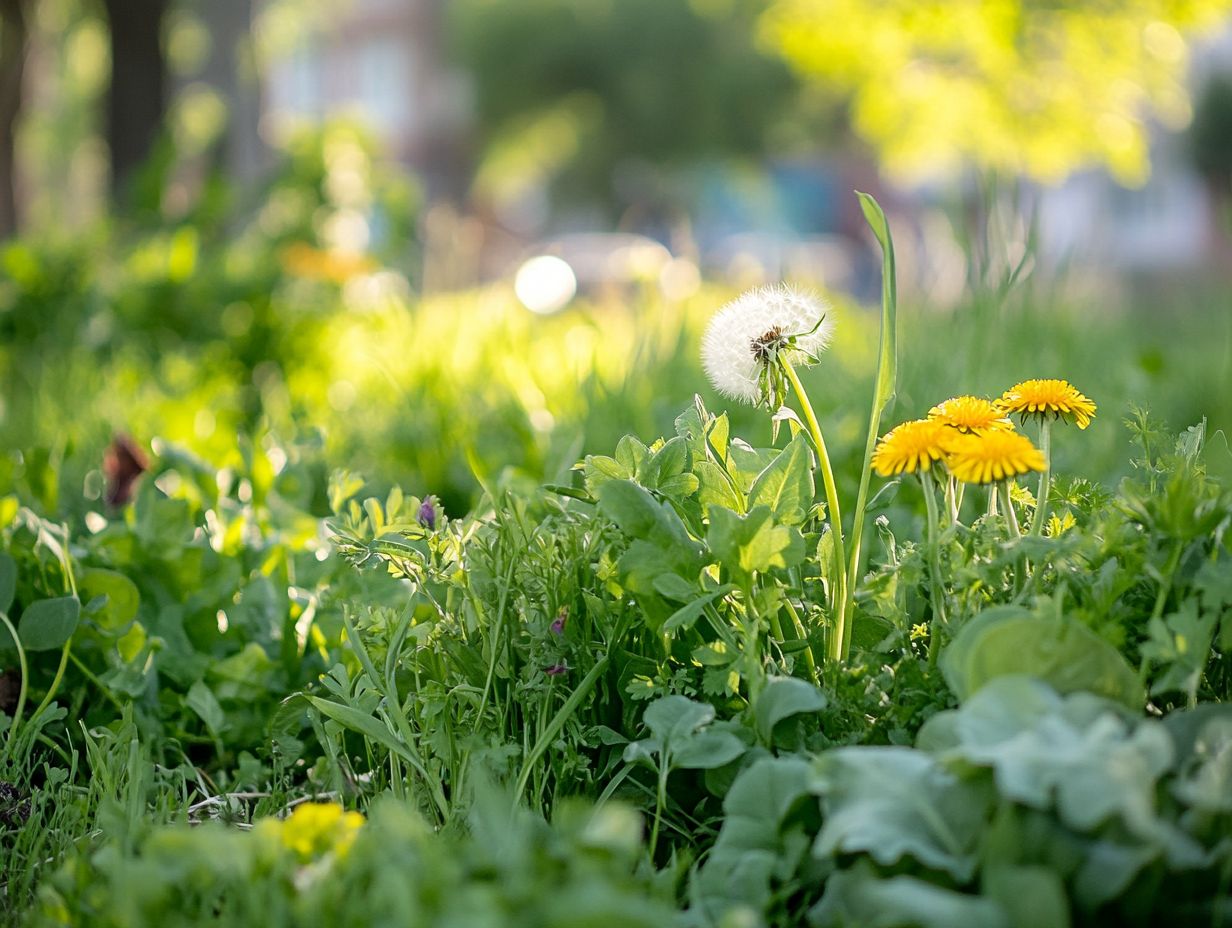
- Urban foraging provides a sustainable and eco-friendly way to source fresh, nutritious food.
- Before foraging, research and take safety precautions to avoid consuming contaminated or poisonous plants.
- Dandelion, purslane, lamb’s quarters, chickweed, and wild garlic are easy to identify and harvest in urban areas, making them great options for urban foraging.
1. Dandelion
Dandelions, often dismissed as weeds, are nutrient-rich plants. They contribute to a sustainable food culture and offer a variety of culinary options.
From their vibrant flowers to their leafy greens, dandelions serve as versatile ingredients. You can find these resilient plants thriving in city parks, where foraging for wild greens and berries can be a delightful experience.
In cities like London and Chicago, foraging communities such as Four Season Foraging, led by experts like Dave Odd celebrate the thrill of discovery in their culinary adventures.
The entire dandelion plant, including the leaves, flowers, and roots, is prized for its numerous health benefits. The young leaves are fantastic in salads or saut ed dishes, providing a pleasantly bitter yet refreshing flavor. The bright yellow flowers can be transformed into dandelion wine or infused into oils for dressings.
Packed with vitamins A, C, and K, as well as essential minerals like calcium and potassium, dandelions make a significant contribution to a well-rounded diet. For those foraging in urban areas, it s crucial to identify clean, chemical-free spaces; parks and gardens usually provide ideal habitats.
Engaging in this sustainable practice not only enhances your personal health but also fosters a shared responsibility toward nurturing local ecosystems.
2. Purslane
Purslane, that often-overlooked succulent edible plant, is a hidden gem packed with omega-3 fatty acids healthy fats that support heart health and a medley of nutrients. It s an invaluable addition to your foraging repertoire.
Beyond its impressive nutritional profile, purslane offers a unique, slightly tangy flavor complemented by a delightful crunch. This robust plant thrives in full sun and well-drained soil, showcasing its remarkable adaptability and resilience to drought and poor soil conditions.
When harvested in season, particularly from late spring to early fall, you can savor the tender, young leaves that elevate salads, sandwiches, and soups. Embracing purslane not only enhances your culinary adventures but also supports local food enthusiasts who cherish the bounty of urban foraging.
Join the movement and experience the joys of foraging! Your culinary creations await.
3. Lamb’s Quarters
Lamb’s Quarters, a wild green often discovered in city parks, is not only a delightful addition to your plate but also a powerhouse of nutrition, brimming with vitamins and minerals that can elevate any culinary experience.
To recognize this culinary treasure, look for its slightly hairy, triangular leaves adorned with a distinctive silvery-white underside. The edible parts include tender leaves, young stems, and even seeds, making it a remarkably versatile ingredient for a variety of dishes.
- You can toss it into salads for a refreshing crunch.
- Saut it with garlic for a flavorful side that impresses.
- Blend it into smoothies for an effortless nutrient boost.
As part of the urban foraging movement, lamb’s quarters beautifully illustrates the art of transforming nature’s gifts into wholesome meals. It nurtures a sustainable food culture that embraces local and seasonal eating.
4. Chickweed
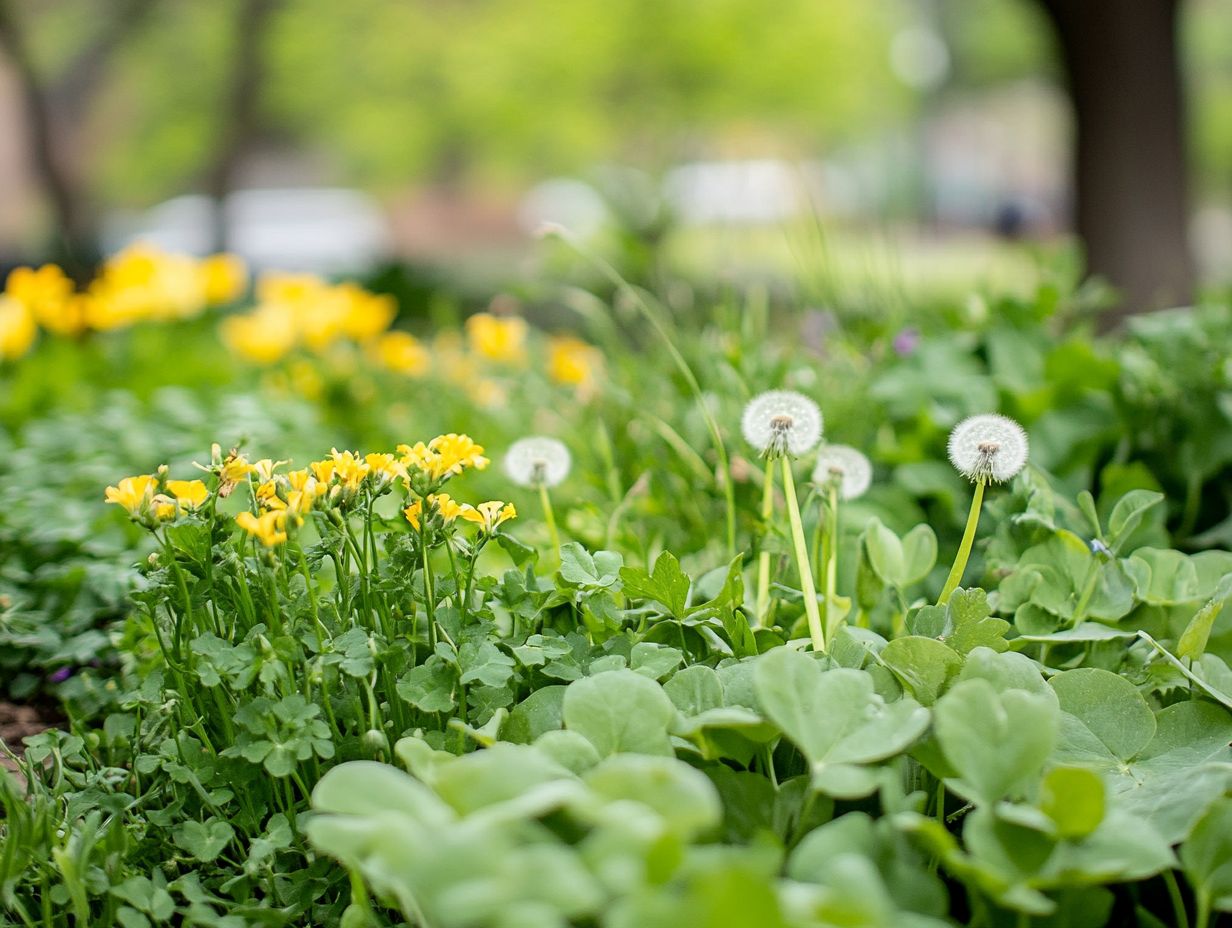
Chickweed, a charming wild plant, stands out for its tender leaves and mild flavor, making it a delightful choice for urban foragers eager to elevate their local cuisine with wild food.
You ll often spot this herb in gardens and along pathways. It s easily identifiable by its small white star-like flowers and pointed, oval leaves that grow in pairs along slender, creeping stems.
Chickweed is not just about looks; it also boasts impressive health benefits. Rich in vitamins A and C, antioxidants, and minerals, it s known to support skin health and boost immunity.
Culinary enthusiasts like to weave chickweed into fresh salads for a subtle crunch and a pop of vibrant green, or use it as an elegant garnish on soups and entrees.
By joining park foraging groups, you can dive deeper into the world of edible plants. This helps nurture a stronger connection with nature while fostering community awareness about sustainable food sourcing.
5. Wild Garlic
Wild Garlic, often lurking in the shaded corners of city parks, is an aromatic edible gem that can transform your dishes with its robust flavor, while inviting you to embrace sustainability and a deeper connection with nature!
This versatile herb opens up a world of cooking options, from invigorating pestos to enhancing the depth of soups and salad dressings. If you re into foraging, you ll find it easy to spot with its broad, green leaves that release a distinct garlic scent when crushed.
Typically harvested in spring, wild garlic encourages urban dwellers like you to indulge in eating foods that are in season. It plays a vital role in urban food culture by prompting local sourcing and the use of wild ingredients.
Its presence in city landscapes not only nurtures biodiversity but also fosters a sense of community. This inspires both chefs and home cooks to delve into the rich flavors that nature has to offer.
What Is Urban Foraging and How Does It Benefit the Environment?
Urban foraging invites you to search for and gather wild edible plants in urban environments, offering a unique opportunity to reconnect with nature. Not only does this practice promote sustainability and reduce reliance on commercial food sources, but it also enriches the local food culture in vibrant cities like London and Chicago. Knowing about 5 edible plants to know for survival can enhance your foraging experience.
Tracing back to our ancestors who depended on wild plants for sustenance before agriculture took hold, this age-old tradition is making a comeback. In recent years, you may have noticed a resurgence as community members become increasingly aware of their environmental impact and aspire to cultivate a more sustainable lifestyle.
You can discover the myriad benefits of urban foraging, such as enhancing biodiversity in urban settings and minimizing food waste by utilizing overlooked resources. Additionally, exploring the top 5 edible fungi for sustainable foraging can enrich your experience. Educational initiatives are cropping up, teaching participants about native flora and fostering a sense of community.
These efforts can create ripples throughout neighborhoods, leading to a more engaged and environmentally conscious citizenry.
What Are the Precautions to Take When Foraging in an Urban Environment?
When foraging in an urban environment, you should take precautions to ensure your safety. Knowing how to identify plants, including 5 edible plants to find in woodlands, is vital, and you should avoid areas that may be contaminated to keep your foraging enjoyable and safe.
- Start by thoroughly researching potential foraging locations. Understanding local regulations regarding foraging is essential; it can save you from any legal issues down the line.
- Familiarize yourself with areas known for pollution, such as spots near roadways or industrial sites, to minimize the risk of gathering contaminated plants.
- Recognizing local flora is crucial; this knowledge enables you to distinguish between edible species and their toxic lookalikes.
Stay aware of other hazards like aggressive wildlife or unsteady terrain to enhance your safety. With each foraging experience, you’ll learn important skills that make every foraging trip an adventure! In time, you’ll find foraging to be a truly rewarding endeavor.
How Can One Identify and Harvest These Edible Plants Safely?
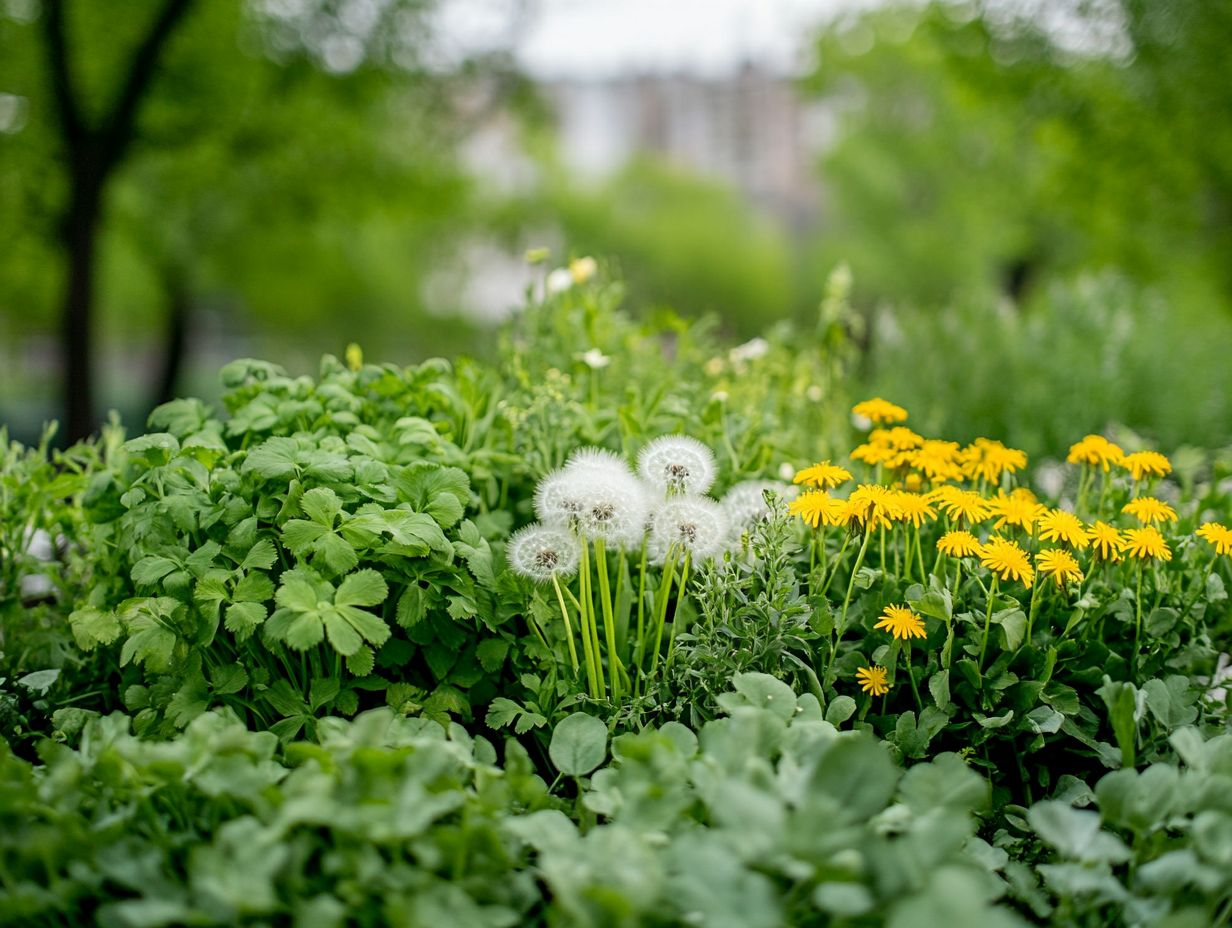
Identifying and safely harvesting edible plants requires you to develop a keen understanding of their characteristics. This ensures that you can confidently select nutritious options while steering clear of harmful species in your urban environment, especially with resources like identifying edible plants in urban areas.
By learning key features such as leaf shape, flower color, and growth habits you ll boost your foraging success. For example, dandelion greens stand out with their jagged, rosette-shaped leaves and vibrant yellow flowers, making them a delightful and nutritious addition to salads. Similarly, wild garlic reveals itself through its distinctive onion-like aroma and broad leaves, typically found in damp woodlands.
It s crucial to employ careful harvesting techniques, like using clean hands or tools, to avoid contaminating these valuable plants. If you’re eager to expand your knowledge, foraging guides and local workshops can provide the essential information and confidence you need for responsible gathering.
What Are the Nutritional Benefits of These Edible Plants?
Edible plants discovered through foraging are often nutrient-dense, offering a multitude of health benefits that contribute to a well-rounded diet. For example, learning about the 5 essential plants to forage in spring can promote overall wellness while minimizing your environmental impact.
These wild treasures present a diverse array of vitamins and minerals that can significantly elevate your nutritional intake. Take dandelion greens, for example; they are brimming with vitamins A, C, and K, alongside essential minerals like iron and calcium, making them a formidable ally for bone health and immune function. Similarly, stinging nettles aren t just rich in iron and magnesium; they also possess remarkable anti-inflammatory properties.
Engaging in foraging allows you to connect deeply with your local ecosystem while supporting sustainable practices that reduce the carbon footprint associated with commercial farming. By embracing this approach, you contribute to a more resilient local food system.
How Can These Edible Plants Be Used in Cooking?
The diverse array of edible plants available through foraging opens up a world of culinary possibilities for you. It allows you to explore unique flavors and textures while incorporating wild food into your meals.
Imagine experimenting with ingredients like wild garlic, celebrated for its robust and aromatic flavor, or dandelion greens, which add a delightful touch of bitter zest to your dishes. You can elevate everyday meals into extraordinary culinary experiences. Chickweed, with its delicate and mild taste, serves as a wonderful addition to salads or a charming garnish for soups.
The key lies in blending these foraged treasures with traditional cooking techniques saut ing, blanching, or pureeing inviting creativity and encouraging a bold spirit as you experiment with wild delicacies in your kitchen.
What Are Some Other Edible Plants That Can Be Found in Urban Areas?
Beyond the familiar dandelion and wild garlic, urban areas are filled with edible plants waiting to be discovered. For those interested in foraging, the top 5 wild edibles for beginners include wild berries, mulberries, and serviceberries, offering exciting wild food options.
Take purslane, for instance. With its succulent leaves and a subtly tangy kick, it often makes its home along garden beds and sidewalks. This delightful green can add a burst of flavor to your salads and stir-fries! Then there s lamb’s quarters, frequently misidentified as a mere weed, yet celebrated for its healthy greens that can be prepared similarly to spinach.
Identifying these plants can be a rewarding adventure. Pay attention to their growth cycles and unique leaf shapes to harvest successfully. You might consider diving into seasonal foraging opportunities! Perhaps by attending a community workshop, you can immerse yourself in sustainable practices and connect with fellow enthusiasts eager to share insights about 5 unique wild edibles you can find nestled within the urban landscape.
Frequently Asked Questions
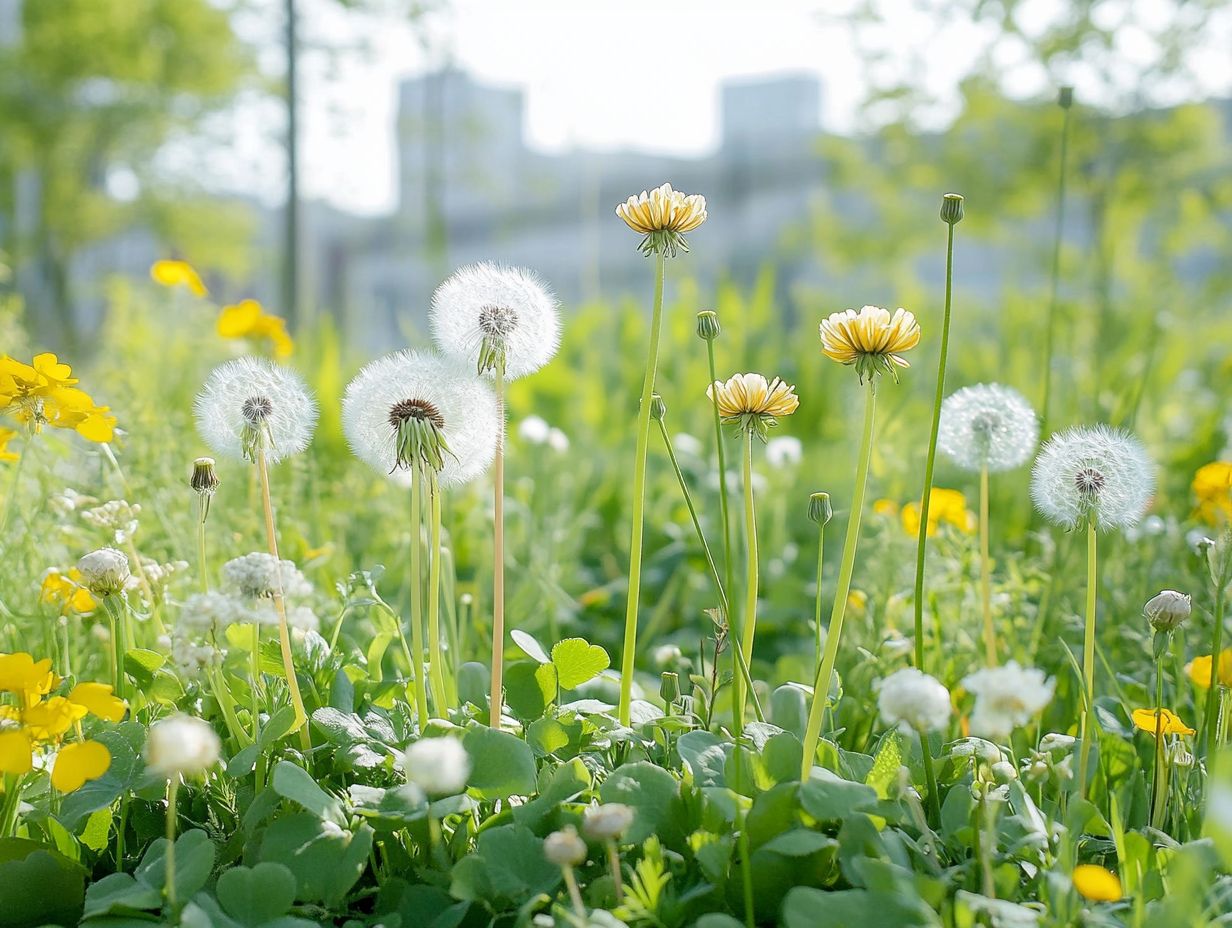
What are the top 5 best edible plants for urban foraging?
The top 5 edible plants for beginners to forage in urban areas are dandelion, mulberry, wild strawberry, purslane, and chickweed. These plants are not only easy to find in urban areas, but also have high nutritional value.
How do I identify dandelion for foraging in an urban environment?
Dandelions have bright yellow flowers and jagged, dark green leaves. They also have a long, hollow stem and a taproot. Make sure to avoid picking dandelions from areas that may have been sprayed with pesticides.
Can I eat mulberries straight from the tree in urban areas?
Yes, mulberries can be eaten straight from the tree in urban areas. They are small, dark purple berries that grow on trees and are similar in appearance to blackberries. Make sure to wash them thoroughly before consuming.
What are the benefits of foraging for wild strawberries in urban areas?
Wild strawberries are not only delicious, but they are also rich in vitamin C, antioxidants, and other essential nutrients. Foraging for them in urban areas is a great way to incorporate fresh, healthy food into your diet.
Are there any precautions I should take when foraging for purslane in urban areas?
Purslane is a common and nutritious edible plant, but it is important to be cautious when foraging for it in urban areas. To ensure you’re picking safely, refer to the top 10 edible plants to harvest sustainably and make sure to pick it from unpolluted areas and wash it thoroughly before consuming.
Can I use chickweed for anything other than eating in urban foraging?
Chickweed can also be used for medicinal purposes, such as reducing inflammation and relieving skin irritations. It can also be used as a natural fertilizer for plants. Make sure to research proper preparation methods before using it for non-food purposes.
Start your foraging journey today and discover the hidden treasures in your neighborhood!

